You have been given a bag with some things in it that you will
work with during the next 20 minutes. Take all of the things out
of the bag and put them on your desk. Now look at the picture below.
Do you have everything that is shown in the picture? If you are
missing anything, raise your hand and you will be given the things
you need.
Now you will use the things on your desk to do some activities
and answer some questions about those activities. Follow the directions
step-by-step and write your answers to the questions in the space
provided in your booklet.
- Open the bottle labeled Fresh Water. Pour
all of the fresh water into the cylinder. Put the cap back on
the bottle.
After you add the fresh water to the cylinder, what is the total
amount of water in the cylinder? ____________milliliters
(mL)
Now use the red marker to draw a short line on the side of the
cylinder to show how much water is in it.
Now take the pencil and put it in the water in the cylinder, eraser-end
down.
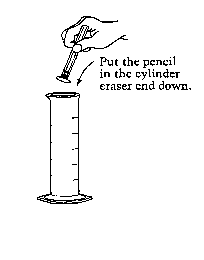
- How much water is is in the cylinder now that you have
put the pencil in it? (Fill in the oval in front of the best answer.)
 More water than before
the pencil was added
More water than before
the pencil was added
 The same amount of
water as before the pencil was added
The same amount of
water as before the pencil was added
 Less water than before
the pencil was added
Less water than before
the pencil was added
Tell why you think so.
____________________________________________________
____________________________________________________
____________________________________________________
____________________________________________________
____________________________________________________
____________________________________________________
- Look at the pencil in the fresh water. There are letters
along the side of the pencil. Make sure the pencil is not touching
the side of the cylinder. Note the exact level where the water
surface meets the side of the pencil, as shown in picture A. Then
draw a line on picture B where the water surface comes to on your
pencil. This line will help you to remember where the water level
comes on your pencil for the next step (4).
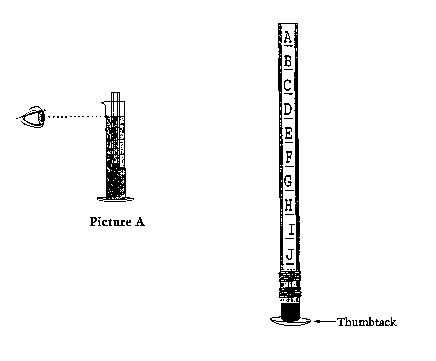
- Now take the pencil out of the water and dry it with
a paper towel. Use the ruler printed below to measure the length
of the pencil that was above the water. Draw a line
on the ruler to show how much of the pencil was above the
water.

How long was the part of the pencil that was above the water?
______________ centimeters (cm)
Now pour the fresh water out of the cylinder into the large
plastic bowl. Later you will throw this water away.
Open the bottle labeled Salt Water. Add salt
water to the cylinder up to the red line. Put the cap
back on the bottle.
- Now take the pencil and put it in the cylinder, eraser-end
down. How does the way the pencil floats in the salt water compare
with how it floated in the fresh water? (Circle the letter in
front of the best answer.)
- In the salt water, the pencil sinks below the water surface.
- In the salt water, more of the pencil is below the water
than before.
- In the salt water, more of the pencil is above the water
than before.
- In the salt water, the same amount of the pencil is above
the water as in the fresh water.
- Look at the pencil in the water. Look at the letters
along the side of the pencil, as shown in picture A. Where does
the salt water come up to on the pencil? Now look at picture B.
Draw a line on picture B where the water level comes to on your
pencil.
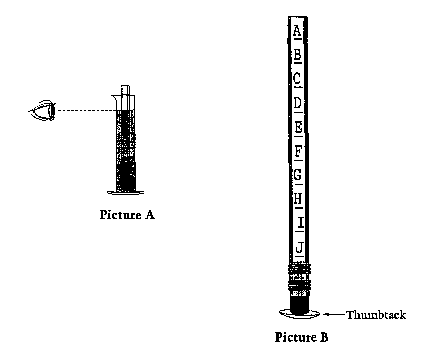
- Now take the pencil out of the salt water and dry it
with a paper towel. Use the ruler printed below to measure the
length of the pencil that was above the salt water. Draw
a line on the ruler to show how much of the pencil was above
the water.

How long was the pencil that was above the salt water?
_________________ centimeters (cm)
- If you dissolved more salt in the salt water, how would
this change the way that the pencil floats? (Fill in the oval
in front of the best answer.)
 The pencil would float
higher than it did before the extra salt was added.
The pencil would float
higher than it did before the extra salt was added.
 The pencil would float
at the same level as it did before the extra salt was
added.
The pencil would float
at the same level as it did before the extra salt was
added.
 The pencil would float
lower than it did before the extra salt was added.
The pencil would float
lower than it did before the extra salt was added.
Now pour the salt water out of the cylinder into the large
plastic bowl. Later you will throw this water away.
- Now use the floating-pencil test to find out if the water
in the bottle labeled Mystery Water is fresh water
or salt water. Do your test just like you did for the fresh water
and the salt water. For this test, you can draw lines on the pictures
of the pencil and the ruler below.
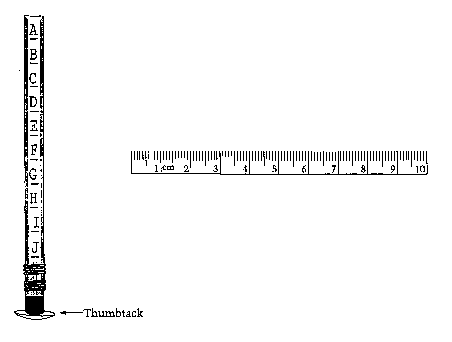
- Is the mystery water fresh water or is it salt water?
______________________________________________________________________
How can you tell what the mystery water is?
______________________________________________________________________
______________________________________________________________________
______________________________________________________________________
______________________________________________________________________
______________________________________________________________________
______________________________________________________________________
Now pour the mystery water into the large plastic bowl.
- When people are swimming, is it easier for them to stay
afloat in the ocean or in a freshwater lake?
______________________________________________________________________
Explain your answer.
______________________________________________________________________
______________________________________________________________________
______________________________________________________________________
______________________________________________________________________
______________________________________________________________________
______________________________________________________________________
Use the paper towels to wipe up any spills. Be sure that the lids
on the bottle are tightly closed. Then put the cylinder, the pencil,
the marker, and the bottles back into the large plastic bag. Someone
will collect the paper towels and the bowl with the solution in
it.


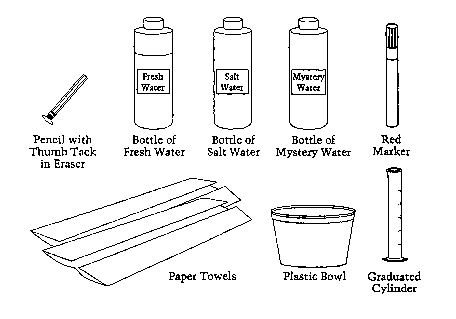

 More water than before
the pencil was added
More water than before
the pencil was added
 The same amount of
water as before the pencil was added
The same amount of
water as before the pencil was added
 Less water than before
the pencil was added
Less water than before
the pencil was added




